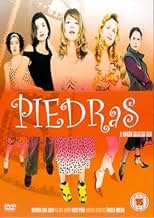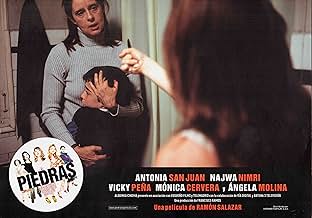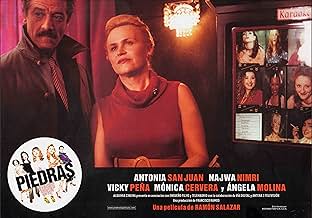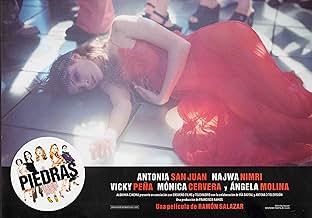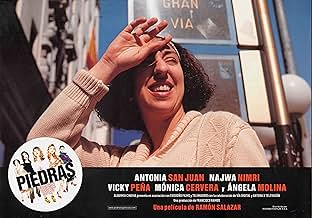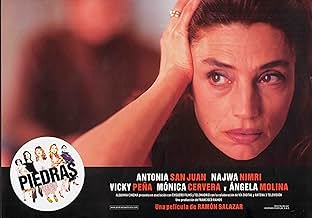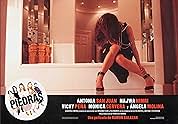AVALIAÇÃO DA IMDb
6,9/10
1,7 mil
SUA AVALIAÇÃO
O filme conta a trajetória paralela e contraditória de cinco mulheres, todas se esforçando para retirar as pedras que aparecem com insistência em seus caminhos, ou ainda pior, em seus sapato... Ler tudoO filme conta a trajetória paralela e contraditória de cinco mulheres, todas se esforçando para retirar as pedras que aparecem com insistência em seus caminhos, ou ainda pior, em seus sapatos.O filme conta a trajetória paralela e contraditória de cinco mulheres, todas se esforçando para retirar as pedras que aparecem com insistência em seus caminhos, ou ainda pior, em seus sapatos.
- Prêmios
- 9 vitórias e 6 indicações no total
Avaliações em destaque
Spanish films are into a, if not Golden, definitely a Silver Age. Piédras is another example of a movie that takes people and their conflicts seriously. Although the feelings are strong or nearly at life or death-level, they still aren't really melodramatic. This could happen.
There are different stories here, which become connected. One is about the retarded girl, who doesn't dare to pass the street to the next block. One is about the middle-aged woman who finds the lover of her life in a foot fetischist. Another is about the girl with drug problems who's lover leaves her. Still another one is about the madame of a brothel who (almost) finds true love.
Definitely worth seeing. It's in Spain the moviemakers take women seriously.
There are different stories here, which become connected. One is about the retarded girl, who doesn't dare to pass the street to the next block. One is about the middle-aged woman who finds the lover of her life in a foot fetischist. Another is about the girl with drug problems who's lover leaves her. Still another one is about the madame of a brothel who (almost) finds true love.
Definitely worth seeing. It's in Spain the moviemakers take women seriously.
Women have never looked so attractive and pathetic as in Salazar's film Piedras. Although editor's cut here and there might help the film, it is exciting and enjoyable with an intense mark from Pedro Almodovar's latest films. 5 different women are coping with their male partners and families. Beginning with several different stories bound to meet as the plot goes on, Salazar portraits his women characters in the same neurotic and border-line behaviour familiar to Almodovar. A kleptomaniac high society lady with a fattish to smaller shoes, a burlesque house madam taking care of her disabled daughter, a drug addict dancer obsessed with her former boyfriend and a taxi-driver taking care of her late husband's disturbed kids, all roaming the streets of Madrid in well designed scenes. Using some of Almodovar's familiar actresses, the director succeeds in it's first film to give depth to all the characters sharing the film, and to create genuine sympathy with each of them. The women controls the plot line, and the men are bound to be left with each other, eventually... Surprisingly good for a first film, and worth the time in any standard. It is noticeable that Salazar hesitated in some needed guidelines to the actresses, but an impressible act is shown anyway on the screen, especially by Monica Cervera, which played in his former short film.
A must to all Almodovar's fans, and enjoyable to all.
A must to all Almodovar's fans, and enjoyable to all.
Well i do disagreed with the other comment posted. Piedras is much much better them Magnolia or any of the other films that were mentioned.
specially about non real characters, i think that someone just wrote that only because he never lived in the Spanish society like i did (and i'm not Spanish), is a very real film with real characters, very well done by one of the best Spanish actress Antonia San Juan.
about be a European film in contrast with an American film, well we different societies, personally i dislike American modern films a lot (i like the classics and some of the Andy American films but they are very few).
Is a film about the continuous Constitution of a person, liked or not we all make mistakes but some can learn about the mistakes.
specially about non real characters, i think that someone just wrote that only because he never lived in the Spanish society like i did (and i'm not Spanish), is a very real film with real characters, very well done by one of the best Spanish actress Antonia San Juan.
about be a European film in contrast with an American film, well we different societies, personally i dislike American modern films a lot (i like the classics and some of the Andy American films but they are very few).
Is a film about the continuous Constitution of a person, liked or not we all make mistakes but some can learn about the mistakes.
Several story lines are interwoven here around different women characters. The shoes they wear serve as an indication of their troubled lives. All are transformed at the end of the movie. Adela (Antonia San Juan) leads a brothel; Her daughter Anita (Monica Cervera) is retarded and has a restricted life. Leire (Najwa Nimri) is a shoe designer with problems and loses her boyfriend; Maricarmen (Vicky Peña) has lost her husband and now raises the children from his deceased former wife. Isabel (Ángela Molina) is a bored rich lady.
Other characters are used to connect the five main women characters. In storytelling not everything is given away in the beginning: Some connections are established surprisingly late in the movie and that adds to the experience. The shoe-theme is driven to extremes: For example when Leire as a shoe-designer and working in a shoe store where she steals her shoes faints, she breaks one of her heels.
In editing small connections are made between the scenes. A telephone rings, a cigarette is lit, a song, etc. are used to make the connection and fast cuts. Frequent change of storyline keeps it from being boring or reaching TV-levels. It is strongly music-driven to set tone and atmosphere. The cities of Madrid and Lisbon serve as the backdrop for the stories, and shots of those cities are used to extend the story beyond the characters. One of the more moving shots is when Anita, who makes the same walk every day, widens her walk and restricted life from the relative calm of her street to the busy main road: How the restriction of space is visually translated is well done. As with most Spanish movies a lot of storytelling is done visually, using the soap-like stories as the simple backdrop. There is a poetic ending that is somewhat romantic and sentimental but is still beautiful.
As Ramón Salazar is too much in love with his own material it is overlong. Some scenes are kitsch and on the soap level, including the acting (Adela's love life, Isabel's doctor). The shoe-theme is exaggerated and is a weak metaphor.
This is often compared to Magnolia because the structure is the same. But they are different. Magnolia is more technically competent, but somewhat mechanical. This has more the ability to translate emotion and atmosphere visually. After seeing this, you are inclined to immediately move to the new movie-city: Madrid.
Other characters are used to connect the five main women characters. In storytelling not everything is given away in the beginning: Some connections are established surprisingly late in the movie and that adds to the experience. The shoe-theme is driven to extremes: For example when Leire as a shoe-designer and working in a shoe store where she steals her shoes faints, she breaks one of her heels.
In editing small connections are made between the scenes. A telephone rings, a cigarette is lit, a song, etc. are used to make the connection and fast cuts. Frequent change of storyline keeps it from being boring or reaching TV-levels. It is strongly music-driven to set tone and atmosphere. The cities of Madrid and Lisbon serve as the backdrop for the stories, and shots of those cities are used to extend the story beyond the characters. One of the more moving shots is when Anita, who makes the same walk every day, widens her walk and restricted life from the relative calm of her street to the busy main road: How the restriction of space is visually translated is well done. As with most Spanish movies a lot of storytelling is done visually, using the soap-like stories as the simple backdrop. There is a poetic ending that is somewhat romantic and sentimental but is still beautiful.
As Ramón Salazar is too much in love with his own material it is overlong. Some scenes are kitsch and on the soap level, including the acting (Adela's love life, Isabel's doctor). The shoe-theme is exaggerated and is a weak metaphor.
This is often compared to Magnolia because the structure is the same. But they are different. Magnolia is more technically competent, but somewhat mechanical. This has more the ability to translate emotion and atmosphere visually. After seeing this, you are inclined to immediately move to the new movie-city: Madrid.
I saw this movie at the 18th Haifa film festival, and it is one of the best I've seen this year. Seeing it on a big screen (and I mean BIG, not one of those TV screens most cinemas have) with an excellent sound system always enhance the cinematic experience, as the movie takes over your eyes and ears and sucks you into the story, into the picture.
The movie presents a set of characters, which are loosely inter-connected. Their stories cross at certain points, and the multiplicity of story lines reminded me very much of the great Robert Altman and his exquisite films. But the true hero of the movie is obviously the city of Madrid, which provides the backdrop for the entire movie. It houses the characters, contains the pavements and roads on which they walk, and sets the background atmosphere for all the events, all in beautifully filmed scenes.
The movie returns again and again to certain themes (shoes, for instance), and in essence Salazar makes his metaphores more and more understandable to the viewer as the movie progresses. He combines the views of the city with the shots of the characters, and elegantly matches the feeling of the scene to the background. A set of talented actors helps him portrait a wide variety of characters. One excellent example is the scene in which Juaquin takes Anita across the street for the first time. It might not work on a small screen, but it gave me goose bumps easily on a big screen.
The message of the movie is very positive, and accordingly the movie is light and funny at times. The music along the movie is usually pop, with a few instrumental pieces (I hope to put my hand on the soundtrack one day, although I seriously doubt I will).
All together, I came out of this movie with a sensational feeling, and I'm not easily impressed (you'll have to take my word for it). For this and more I give this movie a solid 8/10.
The movie presents a set of characters, which are loosely inter-connected. Their stories cross at certain points, and the multiplicity of story lines reminded me very much of the great Robert Altman and his exquisite films. But the true hero of the movie is obviously the city of Madrid, which provides the backdrop for the entire movie. It houses the characters, contains the pavements and roads on which they walk, and sets the background atmosphere for all the events, all in beautifully filmed scenes.
The movie returns again and again to certain themes (shoes, for instance), and in essence Salazar makes his metaphores more and more understandable to the viewer as the movie progresses. He combines the views of the city with the shots of the characters, and elegantly matches the feeling of the scene to the background. A set of talented actors helps him portrait a wide variety of characters. One excellent example is the scene in which Juaquin takes Anita across the street for the first time. It might not work on a small screen, but it gave me goose bumps easily on a big screen.
The message of the movie is very positive, and accordingly the movie is light and funny at times. The music along the movie is usually pop, with a few instrumental pieces (I hope to put my hand on the soundtrack one day, although I seriously doubt I will).
All together, I came out of this movie with a sensational feeling, and I'm not easily impressed (you'll have to take my word for it). For this and more I give this movie a solid 8/10.
Você sabia?
- CuriosidadesFanny de Castro is of Spanish ancestry.
- Erros de gravaçãoIn the second scene at the chiropodist, a cameraman can be seen reflected in the glass window.
- Versões alternativasThe 2004 UK Cinema Club DVD was cut by 19 secs to remove shots of a dog being swung from a balcony by its lead. The cuts were waived for the 2010 Arrow release.
- ConexõesFeatures Sor Citroen (1967)
Principais escolhas
Faça login para avaliar e ver a lista de recomendações personalizadas
Detalhes
Bilheteria
- Faturamento bruto mundial
- US$ 1.013.638
- Tempo de duração2 horas 15 minutos
- Cor
- Mixagem de som
- Proporção
- 2.35 : 1
Contribua para esta página
Sugerir uma alteração ou adicionar conteúdo ausente


